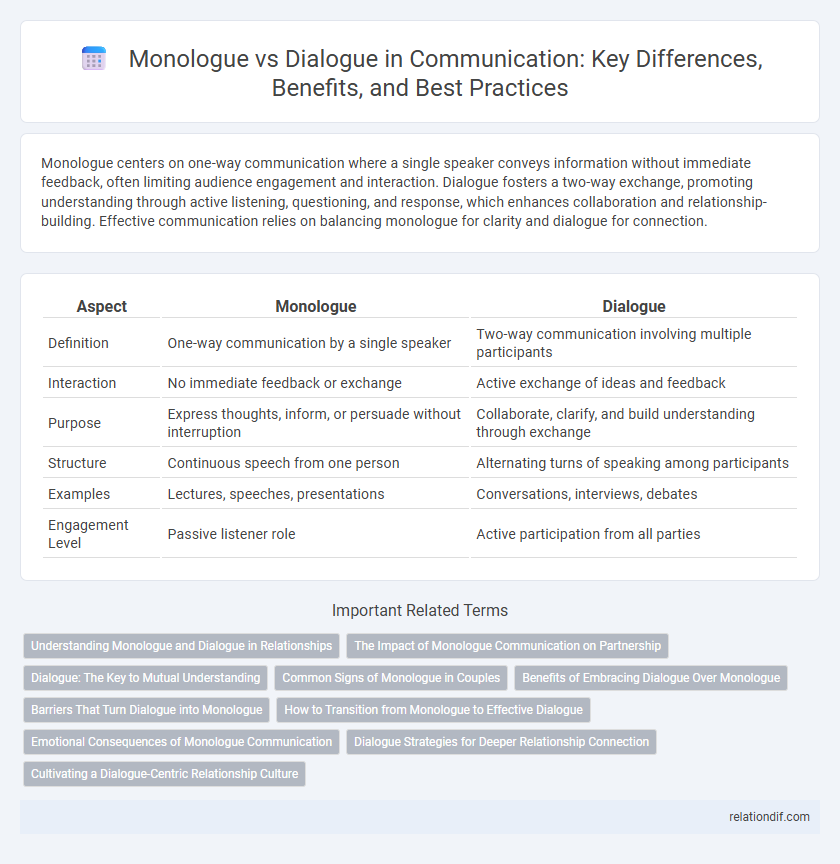Monologue centers on one-way communication where a single speaker conveys information without immediate feedback, often limiting audience engagement and interaction. Dialogue fosters a two-way exchange, promoting understanding through active listening, questioning, and response, which enhances collaboration and relationship-building. Effective communication relies on balancing monologue for clarity and dialogue for connection.
Table of Comparison
| Aspect | Monologue | Dialogue |
|---|---|---|
| Definition | One-way communication by a single speaker | Two-way communication involving multiple participants |
| Interaction | No immediate feedback or exchange | Active exchange of ideas and feedback |
| Purpose | Express thoughts, inform, or persuade without interruption | Collaborate, clarify, and build understanding through exchange |
| Structure | Continuous speech from one person | Alternating turns of speaking among participants |
| Examples | Lectures, speeches, presentations | Conversations, interviews, debates |
| Engagement Level | Passive listener role | Active participation from all parties |
Understanding Monologue and Dialogue in Relationships
Monologue in relationships often limits emotional connection as it centers on one person's perspective, reducing opportunities for mutual understanding and empathy. Dialogue promotes active listening and shared exchange, fostering trust and deeper emotional bonds. Effective communication relies on balancing monologue and dialogue to enhance clarity while encouraging collaboration and emotional insight.
The Impact of Monologue Communication on Partnership
Monologue communication often limits effective partnership by restricting the flow of ideas and reducing collaborative problem-solving opportunities. When one party dominates the conversation, it can lead to misunderstandings, decreased trust, and a lack of engagement from others. Prioritizing dialogue fosters mutual understanding and strengthens partnership by encouraging active listening and shared input.
Dialogue: The Key to Mutual Understanding
Dialogue fosters mutual understanding by enabling active listening and empathetic exchange between participants, which strengthens interpersonal connections. It encourages the sharing of diverse perspectives, facilitating resolution of conflicts and collaborative problem-solving. Unlike monologues, dialogues create dynamic interactions that promote clarity, trust, and meaningful communication outcomes.
Common Signs of Monologue in Couples
Common signs of monologue in couples include one partner consistently dominating conversations, frequently interrupting or dismissing the other's input, and showing little interest in reciprocal exchange. Emotional withdrawal or frustration often arises when one person monopolizes dialogue, leading to imbalance and communication breakdown. Recognizing these patterns is crucial for fostering healthier, more engaged interactions.
Benefits of Embracing Dialogue Over Monologue
Embracing dialogue fosters active listening and collaborative problem-solving, enhancing mutual understanding and trust between participants. Dialogue encourages diverse perspectives, leading to more innovative and well-rounded solutions compared to the one-sided nature of monologue. This interactive communication style improves engagement, accountability, and relationship-building within personal and professional settings.
Barriers That Turn Dialogue into Monologue
Barriers that turn dialogue into monologue include lack of active listening, dominant speaking styles, and emotional defensiveness, which prevent genuine exchange. In communication, these obstacles reduce interaction to one-sided speech, diminishing mutual understanding and collaboration. Overcoming these barriers requires fostering openness, empathy, and balanced participation in conversations.
How to Transition from Monologue to Effective Dialogue
Transitioning from monologue to effective dialogue requires active listening and open-ended questioning to promote engagement and understanding. Encouraging feedback and incorporating diverse perspectives transform one-sided communication into collaborative exchanges, enhancing clarity and connection. Structuring conversations to balance speaking and listening optimizes interaction flow and fosters mutual respect in communication.
Emotional Consequences of Monologue Communication
Monologue communication often leads to emotional isolation as the speaker dominates the conversation without feedback, causing feelings of frustration and misunderstanding in the listener. This one-sided interaction limits emotional connection and empathy, increasing the risk of resentment and disengagement. In contrast to dialogue, where mutual exchange fosters emotional support, monologues can hinder trust-building and damage relationships over time.
Dialogue Strategies for Deeper Relationship Connection
Dialogue strategies such as active listening, empathetic responses, and open-ended questions foster deeper relationship connections by encouraging mutual understanding and emotional exchange. Implementing reflective feedback reinforces trust and clarity, allowing both parties to feel heard and valued. Prioritizing transparency and vulnerability in conversations enhances intimacy and strengthens relational bonds over time.
Cultivating a Dialogue-Centric Relationship Culture
Cultivating a dialogue-centric relationship culture fosters active listening and mutual understanding, which enhances collaboration and trust within teams. Unlike monologues that prioritize one-way communication, dialogues promote open exchange of ideas, encouraging diverse perspectives and creative problem-solving. Embedding dialogue practices in organizational communication strategies leads to stronger connections and more effective conflict resolution.
monologue vs dialogue Infographic

 relationdif.com
relationdif.com